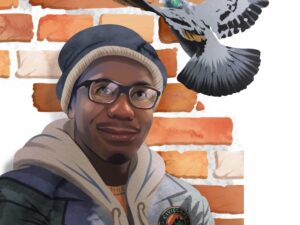At 16, Javier Ochoa Reyes left his family, and the small village in Mexico where he lived, to go to school and find work in the United States so he could expand his horizons and help his family. He settled in Richmond and worked several jobs while he went to high school. Through involvement with several program for teens in Richmond he discovered a passion for helping youth, and the environment, which led eventually to his work with Groundwork Richmond. At Groundwork Reyes teaches high school-age youth about the importance of trees in urban environments, and works with the students to create more green spaces in Richmond, including stewardship of segments of the Richmond Greenway. At the same time, he is pursuing a degree in civil engineering at Contra Costa College.
Jennifer Baires: You were born in San Pablo here in the Bay Area but you grew up in La Esperanza in Mexico. What was it like there?
Javier Ochoa Reyes: It was a rustic place. It isn’t a city; it’s a small village. I was working in agriculture and going to school at the same time. We worked a lot, planting corn and strawberries.
JB: How old were you when you started working?
JOR: I think five years old. We’d also fish and go to the mountains nearby to hunt for food.
JB: It doesn’t sound like there was much time to play or explore.
JOR: There was not a lot of playing outside. Not because my parents didn’t want me to, but more because I felt bad playing when I knew we needed to work. I come from a really poor ranch and a really poor family. There were times when we didn’t have money to buy anything to eat. It was hard. We were nearly starving and that’s why I decided to come back here by myself.
JB: How did you end up in Richmond?
JOR: I wanted to find a job and help my family. I was born in San Pablo and a few of my uncles were here, so I moved in with one of them and started working.
JB: What were the first few days and weeks like for you?
JOR: They were terrible. They were really sad. I felt like I was on another planet. I felt restricted about going out at night because I was living in a more dangerous area. I didn’t really know my uncles because they’d lived here all my life. So I was really close to going back to Mexico, but the educational opportunities here, and work, were really good. I got a job within a couple of weeks and decided to stay and start school.
JB: Did you speak English when you came here?
JOR: No. Not even a word.
JB: What did your day look like in high school?
JOR: I would go to school from 7:00 to 3:00, or 3:30, and then go to work at 4:00. Then from 4:00 to 9:00 I’d work, and then I had another job cleaning stores until early the next morning. Sometimes I would just take a shower and then go to school.
JB: Wow. When would you sleep?
JOR: Sometimes I wouldn’t sleep for one or two days. It was intense.
JB: How did you come to environmental work?
JOR: After I graduated from Richmond High I was taking pre-calculus and chemistry at Contra Costa College and applied for a science tutor position with the city of Richmond, for its Straight Talk On Prison tutoring program that helps at risk-youth stay out of jail through education. While I was tutoring there we partnered with Groundwork Richmond on some volunteer projects.
After about a year the executive director at Groundwork saw how hard I was working and my ability to talk to and motivate the kids. They told me I was a role model for the kids and offered me a project coordinator job. By then, I basically had the experience required; I knew all of their projects and how to do them.
JB: What about the work with Groundwork do you like?
JOR: Richmond is a city with a lot of contamination; I like the fact that we do stuff to help, like planting trees, cleaning parks, and helping the environment. And I love to work with the kids.
JB: Can you tell me about the Greenway Project you’ve been working on?
JOR: The Greenway is 3.5-mile bicycle and pedestrian path that passes through the heart of Richmond. We have two sites on the Greenway we’re responsible for keeping free of garbage. Our long-term plan for those sites is to build a park on each one. But that requires funding and we’re still raising money.
So far, we’ve cleaned both sites, laid down mulch over the areas, and at the spot on 42nd Street and Ohio Avenue we painted a mural to show the history of Richmond. We visit the sites at least twice a month to weed and beautify the place to motivate the neighbors to keep it clean.
JB: Why do you like the environmental aspect?
JOR: I worked outdoors in Mexico, so I feel kind of at home outdoors. Plus, Richmond is my community. This is where I live. This is where I want to have my kids. So if I can be part of cleaning it up, I want to.
JB: How does the work you’re doing fit into the broader revitalization of Richmond?
JOR: Besides helping to clean the air, trees look beautiful and reduce crime. The kids are also a big part of it. They’re learning what a tree is for and taking pride in what they’ve done. After they see the trees growing they want to plant more. They call the trees they planted “my tree.”
JB: What do you get, personally, from being out in nature?
JOR: It’s relaxing. Looking at the trees, how they move. The air. It feels like you don’t have to worry about anything. It’s like therapy.
JB: Do you have a favorite park to visit?
JOR: I took 17 units last semester and I work, so I don’t have a lot of time to get outdoors by myself. But whenever I want to take a walk, I go to Point Pinole. I really like it there.
JB: You said you wanted to be a civil engineer. When did you decide to do that?
JOR: When I was in Mexico, working for a construction company. I like that kind of hard work, although as an engineer I wouldn’t be the one doing it.
My biggest goal is to have my own company. I’ve learned a lot about leadership and management. I don’t know if I want to say I learned how to manage a person—that doesn’t sound right—but I’ve learned the best ways to approach them. I want to focus on building homes and having a successful company that would allow me to set up a scholarship foundation to help kids in Mexico get an education. This is one of the things I get excited about.





